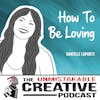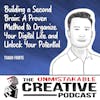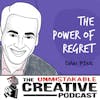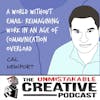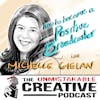Jason Naylor | How to Live a More Colorful Life
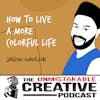
Jason Naylor, an award-winning artist, designer and creative director, joins us to talk about the science and psychology of color as well as how we can live a more colorful life. Jason has developed fascinating insight into how we can be ourselves, be ...
Jason Naylor, an award-winning artist, designer and creative director, joins us to talk about the science and psychology of color as well as how we can live a more colorful life. Jason has developed fascinating insight into how we can be ourselves, be brave, be proud of who we are, be kind, be loving, be happy, and be colorful. Take a listen!
Jason Naylor authored the book Live Life Colorfully, which is available for pre-order right now | https://jasonnaylor.nyc/livelifecolorfully
To find out more about his work, visit Jason's website | www.JasonNaylor.nyc
Listener Tribe
We have our own private social network for listeners of the Unmistakable Creative podcast. You can meet other listeners, discuss episodes, and engage with the creative community! Just visit https://the-unmistakable-creative-podcast.mn.co/ to sign up.
Subscribe for ad-free interviews and bonus episodes https://plus.acast.com/s/the-unmistakable-creative-podcast.
Hosted on Acast. See acast.com/privacy for more information.
Srini Rao: Jason. Welcome to the unmistakable creative. Thanks so much for taking the time to join
Jason Naylor: us. Thanks for having me. I'm so happy to be here.
Srini Rao: Yeah, it is my pleasure to have you here. So I actually found out about your work by way of your publicist who sent me your book live life colorfully which I absolutely love because as I was saying before we hit record here, it was like a combination of a coffee table book with.
Insightful psychology on how color adds to our lives. But before we get into all of that, I want to start by asking what might seem like a very odd question. And that is, do you have siblings? If so, what birth order were you? And what impacted that end up having on the choices that you've made with your life and your career?
Jason Naylor: Okay. That's I love that question. I am one of seven and I am number two. So glad I asked that question then. Oh, it's such a good question for me. Yeah. So a little more about that. I was raised Mormon and so I come from a big family, which is pretty common in Mormon families. And I have six siblings and I was the first son and the second oldest.
I think that plays a huge role in. So much of my life. And I think there's I have like a caretaker personality, which I'm sure can be traced back to being the oldest brother and the older brother to many siblings. And then I think that learning how to like collaborate and cooperate and fit into this big group of.
Obviously, when we were young, it was just mania. And learning those sort of life skills, I think, has helped me in my life in way more ways than I can even address right now.
Srini Rao: Yeah. I want to talk about the mania in more detail. What was an average, once the seventh kid came along at one, what's the age gap between you and the youngest?
And what is an average dinner at your family? Like when all of you are at the table.
Jason Naylor: Yeah. So mania. So the oldest, let's see, let me figure out the range here. I think it's about a 12, 13 year range. So we're pretty close in age year and a half, two years and dinner. So it's very traditional family.
We had dinner together as a family, like at the dinner table as much as possible. And in my memory in my youth, This happened pretty much daily. And I remember feeling like this feeling of I needed to eat, get as much food as I could so that I could be full and not that we couldn't afford to have food or something.
It was like, there was so many people and so much going on that it was like this, I had this sort of order mentality about food. And then the other side of that is I remember we had this dining room table and it had these drawers in either end of it. And you could access the drawer if you reached underneath the table from the side.
Let me see if I'm painting this picture. So if you're sitting at the head or at either end of the table, you have a drawer in front of you. But if you're sitting along either of the sides of the table, you could like, if you don't want to eat your broccoli or something, you could actually slip the broccoli underneath the table and up into the back end of this drawer.
So I hope that's clear. So I remember there always being. stashed in that door because one of us obviously would not want to eat the broccoli or the peas or whatever it was and be slipping the food in while someone else was having a conversation. And then the other thing that that just popped in my head, I totally forgot about this.
My dad is a little bit stern God bless him and. He had this habit of kind of flicking, he would do this like finger flick on the elbow. So if you had your elbows at the table, which is against the rules, you get your elbow flicked. And he would reach down across the table and flick anyone's elbow on the table.
I think I got my elbows flicked plenty of times.
Srini Rao: So this is another question related to the family. Which of the siblings are you closest to and
Jason Naylor: why? So I am closest to... Her name is Laura and she is number four and we both live in New York. So we in our adult life, we have, we've been here together, just the two of us for 15 years, basically.
And so I think that is the primary reason why we're so close, but we have a lot in common. She's a filmmaker, she's very creative and we see eye to eye on many things, including some of the family gossip, which does not It never ends.
Srini Rao: Yeah. I have so many questions about the experience of growing up Mormon because obviously not growing up Mormon.
My entire perception of Mormons is based on what I've learned through pop culture, which it's funny. I don't know if you've ever seen it. There's a South Park episode where a Mormon kid moves to town. And and the thing is the funny thing is they did a really good job because their stereotype was actually incredibly positive.
Like even though they made fun of them, the stereotype was like, the nicest people in the world. And I can tell you from my experience of being a Pepperdine, some of the nicest guys in my business school class were Mormon. So what do you think that from the outside we misunderstand and I'm curious, do you still are you still Mormon by faith or is that something that gets abandoned with age?
And how does that end up affecting your own values and choices that you make in your life
Jason Naylor: later on? It's such an interesting topic. I think the South Park thing is It's so oddly accurate and, and also really funny and really positive. I think we can separate it into two, two parts.
One part is the pop culture depiction of the doctrine that like the nuts and bolts of Mormonism can be negative and can be skewed sometimes. And then the pop culture outlook on. The Mormon culture is that Mormons are super nice and they walk around in pairs of two and knock on your door and they're really friendly.
And those things are also really, I think, pretty accurate and positive. I think that this this culture let me back up to say that the doctrine and the rules and the nuts and bolts of Mormonism are no longer a big part of my life. I've walked away from it. And but however the culture.
And some of the basic fundamental principles that are found in many religions are still a big part of my life. And I, and they're actually a big part of my practice and my work and my artwork. And I don't think that's necessarily a deliberate thing. Like I don't think Mormons would say, be kind.
So I'm going to do art that is about kindness. I think it's just in me and it comes out. I'm working.
Srini Rao: I wonder when you actually no longer practice or go to church or do any of these things because I have seen it happen before. I think the story that comes to mind oddly enough is one about this Mormon girl who ended up becoming a porn star.
And I was like, that is so bizarre that I'm like, I need to interview this girl because I just want to hear that story. But Okay. How does it when some, because I know that it seems like in some cases it basically tears the family apart, whereas in others it doesn't. What happens to family dynamics when you say, okay, you know what I'm going to maintain the values, but the doctrine is no longer going to be something that I make part of my life.
Jason Naylor: For me and for my family, it hasn't been a problem. And actually there's of the whole family, the whole immediate family, there's only one person left who's really practicing. And that's my oldest sister. And even my parents have have since kind of found there are a revised version of the path.
And in, since we've all become adults, my parents have walked away and the relationships have. intact and been just fine. That's not to say that I didn't have to rebel to get here. It was an evolution. It's not one day you say, Hey, mom, dad, guess what? I'm not going to church.
Like it, it slowly happens. And during that process, there is friction. And for me, this was when I was younger like 18, 19, 20 into my adult life, I started. discovering my own path and moving to New York and everything was a big part of that for me. But as I found my own way, I had to rebel against a lot of things in order to get here.
And in order to figure out my own point of view, my own belief set and all those things. But now everything is great. I have an awesome relationship with my parents and religion is. is now like a laughing part of it. Like we all have it under our belts, so to speak. And so we can relate, but we don't go to church.
We don't say prayers before dinner or anything like that anymore.
Srini Rao: So how did One, the advice that your parents gave each of you about making your way in the world change with each sibling. And also, I don't know if this is the case for you, but I feel like my sister got away with murder compared to me as the older sibling, because I feel like in an immigrant family, the first kid is the experiment.
And then they fix everything that they screw up with you on your sister, your sibling
Jason Naylor: totally. I'm sorry, ask me the question
Srini Rao: again. Two things really, two questions really. One is how did the one, how is the experience of each childhood different for each of you in terms of the way the parents were in terms of how strict they were in terms of rules they enforce.
Cause like I was saying, my sister got away with murder, it seems like because she was younger. And also how did. The advice they gave you about making your way in the world changed because I know that most parents aren't like, oh, there's nothing more I want than my son to become an artist and sign up for a life of profound uncertainty.
Jason Naylor: Yeah I, to your point, like the, I think the parenting was a a process that, that got refined by, through each child as each child came, like it was probably a new set of parenting rules for them. And I witnessed that as I got older, I could see that like my youngest sister, for example, like her life was such a cakewalk compared to mine.
And I felt like my. My parents, especially my dad was really hard on me and he really pushed me and drove me and wanted me to have good grades and all these things. And I saw him approach parenting in a very different way with my younger, especially youngest siblings. And so I think that he speaking about my own experience with my parents, they pushed me and they wanted me to.
Grow up and have some stability and have a good job and raise a family and all these things. And so when I went to college I went to BYU, which is a Mormon school, and I studied graphic design. And I always loved technology. I always loved art. And I was comfortable and did well with both of them.
And so to me, graphic design was the solution for my interests, but also it was the solution for growing up and getting a job and having a stable paycheck. So I think that decision was probably driven by the words of wisdom from my parents. But also I think it was something that fit me.
So it was, it actually was a great solution. And I actually don't consider myself to be so much of a graphic designer anymore. I feel like I'm much more of an artist, but the tools that I learned as a designer and in college have led me here. So I think it worked out. I guess the way it was supposed to.
And now my parents are thrilled with what I'm doing. They love that, that I've spun this design career into something that is so unique. And everything worked out.
Srini Rao: I appreciate that because I think that we have this sort of follow your passion narrative that tends to lead people down a lot of bad roads that get them nowhere.
But you've had this practical component to it, which makes a lot of sense, but I want to ask you about one other thing. Did you
Jason Naylor: actually have to do a mission? Yeah, I did.
Srini Rao: So let's talk about that because I'm always curious about this one. What is the purpose of people going in the mission other than spreading the gospel?
Because I feel like there's something greater there than that. It's got to be about you as a person too, right?
Jason Naylor: Yeah. That's really insightful of you to say of course it's like, it is about spreading the gospel and growing growing the membership of the Mormon church, but. It also serves the the duality of it is that it serves this purpose for the individual.
So for me, I went to Brazil and I spent two years walking around with a companion. Knocking on doors and saying, Hey, we're Mormons, like we've got a message for you. And in a way it's like you could, this happens when you're 19 years old. So a 19 year old kid could go to boot camp, join the military, could go on a study abroad, could go on a Mormon mission.
I think what's so beneficial about it. Is that plucks you out of your environment, out of your home, out of your comfort zone, and forces you to go do something new. And on a daily basis, it takes you so far out of your comfort zone that you have to grow. So even though for me, I came back and was like, I don't know about this Mormonism thing anymore.
And to be honest with you, being a missionary and having to learn enough about it to be able to teach it drove me away. Ultimately, I think the more I learned about it, the more I started to question it, but. I came back obviously having grown up so much and changed and evolved and I think those two years, like I wouldn't trade those two years for anything because I found myself in such a way that I don't think I would have if I just stayed in Salt Lake City.
And did what other 19 year old kids were doing.
Srini Rao: So I have to ask because I actually spent six months living in Brazil. I did a study abroad there. Which to me, I'm just imagining you walking around Brazil. What was one of the most formative memories you have from that time there in particular when it comes to an interaction with a person about talking to them about the gospel?
Jason Naylor: I remember, when you're a Mormon missionary, if you don't know, you always have a companion. So you always are in a in a pair. And I remember my first companion was a Brazilian guy and he. I don't even know if he spoke much English, but he didn't speak a word of English to me. And before going to Brazil, I had a crash course at the missionary training center is what it's called.
And I spent six weeks learning the language and learning a little bit about what I was going to be teaching. So I'm with this new companion. I've been in Brazil for two weeks and We're walking around talking to people and he just wouldn't say anything. And so this wasn't like a specific memory.
This was like two months of a memory of me just on a daily basis being thrown into the fire by this guy. And in a way it was great because looking back, it was great because I really. Learned how to speak Portuguese quickly because I had to like, there was no other solution, but at the time and in my memory, it was so brutal.
And I was, I would cry myself to sleep every single night and we would get home and I would be exhausted because we were walking for hours a day and here I am pampered. It's all say the kid, like I didn't, I had never walked anywhere and so it was. Like, it was the worst couple months of my life.
And also, it was such a powerful couple months of my life because I really grew. I really learned to speak and I as brutal as it was, I... Okay. I came out of it alive.
Srini Rao: Yeah. So I wonder what you learned about persuasion and communication from that experience. Cause I can't imagine that you don't experience a lot of people slamming doors in your face because I can for sure tell you that when I've seen people come to my door whether they're people campaigning for a presidential candidate or trying to sell me something, I'm like, yeah, thanks.
Okay. I got to go. And I know cause I've done door to door sales too. So what is what do you learn in terms of communication persuasion and cause I'd imagine they're not people who are not receptive to the message who don't want to hear what you have to say. Yeah.
Jason Naylor: Most people don't want to hear what you have to say.
So you have to learn there are skills that you learn as a missionary and they're very similar to the skills that one would learn if they were embarking on a mission. On the door of their salesman kind of position or something. And it's really sales. That's what it is. You're preaching religion, but what you really are trying to do is develop trust with somebody and offer them something that they don't have and get them to buy it or take it or be interested in it and.
So I learned a lot about communication. The biggest thing that, that we experienced with the Brazilian people was this sort of warm, welcoming please come in and can we offer you some bread or like a a soda or whatever, but not a lot of interest in, not tons of interest in Mormonism or maybe they're interested in hearing what we have to say so that they can chime in with their own Baptist.
But no doors were slammed. Very rarely where we rejected, we just we would always be invited in and we would talk and then we would try to establish some trust and generally speaking, people are not interested, but here and there someone is, and then you feel like you have this big triumph and they get baptized and.
You put a check on the box or whatever it is. So I think that the ultimate the takeaway is that what I learned was, how to develop relationships based on trust and based on common ground. Yeah.
Srini Rao: So what, what actually happens when you actually convert somebody? I'm just curious, like somebody who's not been a lifelong Mormon decides, Hey, you know what?
This sounds good. I'm going to sign up. Cause I remember, and then the reason this comes to my mind and not, it's a this documentary on Scientology. And if you've ever seen the Scientology commercials on TV, like the first three or two minutes ever you're looking at it, you're like yeah, that sounds amazing.
And then at the end they say the church of Scientology and you're like, oh shit. So what is it that gets somebody who has not been a lifelong Mormon to say, you know what, this
Jason Naylor: is for me? The biggest selling point in Brazil Obviously, I can only speak for the region I was in, but the biggest selling point is that, is the idea that families can be together eternally.
In the Mormon doctrine families can be, if members of the family are all baptized and are worthy, righteous, practicing Mormons, then they can all, Move on to the after the celestial kingdom, which is the place you go afterwards and you can all be together. And so without diving too deep into the doctrine here the point is you can you can knock on someone's door and offer them, Hey, do you love your family?
Oh, you do. Okay, cool. Listen to this. You can be with them after you die. How does that sound? And no one's going to be like, no, that's stupid. Everyone's oh yeah, that sounds great. Tell me more. So that's a, that's your in. And I don't know if that is what the missionaries are doing everywhere.
That's what we did, but it makes sense for, especially for Latin culture it. For most people, that is a good sell.
Srini Rao: Yeah did all of your siblings have to do this?
Jason Naylor: No it's required of the men and it's, it's welcomed if the women want to do it, but if, and by required you don't like physically have to do it it's that if you don't do it, you will be shunned culturally.
Srini Rao: Wow. All right. So walk me through how you get from graphic design to art at BYU to New York and what you're doing today. What's been the trajectory of that?
Jason Naylor: So I, when I was in high school, I came to visit my oldest sister who went to Juilliard and when I got to New York, I was just like blown away.
It was this magnetic experience that I felt like. The city was like calling my name like I belong here and I will do anything and everything to get here. And that's that. Just a weekend here left me with that feeling. And so I went back, that was when I was a senior in high school. So then I went back, just felt like then had to go into Born Re Mission and then I ended up at UYU and I was studying graphic design and all the paths were pointing to New York and graphic design at BYU was big.
As part of that trajectory, because. The design program and the professors at BYU who teach graphic design have a lot of network and connections in New York. So I saw that as a stepping stone. I knew that they would be able to help me to find employment once I got to New York since that was my ultimate goal.
And so then, and it did, they did help I got placed in an internship. I came to New York for a summer and I worked at this little design studio and it was like the best summer of my life, of course. And then went back and finished school and then came to New York. Looking for a full time job. And I got a job with Mac cosmetics.
And the reason I got the job is because there was a couple of other guys who had gone to my same school and program who were already working at Mac. So that was a shoe in. Obviously the creative director liked my work and so they wanted to hire me, but you know how it is. You get a job because you often get a job because someone there.
And so that, that was my story as well. And so that kind of. brings me right up to the beginning of my adult life in New York. And one of the, one of the big draws to New York for me was this feeling of freedom, liberation. And I didn't have that at all in Salt Lake City, both because of the city and the Mormon culture.
And when I got to New York, I felt this I can be what I want to be. I can look however I want to look, I can do what I want to do. And it's all fine. It's all great. And New York does that for me. New York. Has that sort of magic. And so I felt like I could just do whatever I wanted to do and be what I want it to be.
And that was the beginning of my adult life and my creative career. And that's now that's 15 years ago. So here we are tired of ads, interrupting your favorite show. Good news. Ad free listening on Amazon music is included with your prime membership. Just head to amazon. com slash ad free lifestyle to catch up on the latest episodes without the ads.
Enjoy thousands of A Cast shows ad free for prime subscribers. Some shows may have ads. Get the best workout with the best kept secret in fitness. Hydro, the state of the art at home rower. Hydro engages 86 percent of your muscles, arms, legs, core, delivering the ultimate full body workout in just 20 minutes.
From advanced to beginner, Hydro has over 4, 000 classes that are shot all over the world and are taught by Olympians and world class athletes. For a 30 day risk free trial with free standard shipping, go to hydro.
Srini Rao: com and enjoy up to 500
Jason Naylor: off during the holidays. That's H Y D R O W dot com. Soon, you'll know Centura Health by a new name, Common Spirit Health.
But you already know who we are. Passionate people who are here to treat, welcome, and support you. Centura is becoming common spirit and you'll continue to find incredible care and caregivers at these and other formerly Centura Health hospitals and clinics. St. Francis Interquest, Penrose, and St.
Mary Corwin Hospitals. Learn more at Centura. org.
Let's talk about
Srini Rao: aging. It's inevitable, right? But what if I told you there's a new way to age, led by Solgar Cellular Nutrition? They believe, and I do too, that you can transform the way you age, cell by cell, with the power of cellular nutrition. As we age, our cellular function declines. Your regular multivitamins and minerals might not be enough to combat these age related declines, and that's where Solgar Cellular Nutrition comes in.
It's formulated with targeted cellular nutrients that work with your body's natural processes deep inside your cells to help you fight cellular decline and promote cell health across three benefit areas. It supports cell energy, repair, and vitality, muscle strength, and even glutathione production to help protect cells.
So let's own our healthy aging narrative. Visit CellularNutrition. Solgar. com to learn more. Again, that's CellularNutrition. Solgar. com to learn more. Solgar Cellular Nutrition. We go cell deep. These statements have not been evaluated by the Food and Drug Administration. This product is not intended to diagnose, treat, cure, or prevent any disease.
The holiday season is up on us and it's time to get that shopping list sorted. But there's no need to break a sweat or play a game of bumper cars in your local mall parking lot. Our friends at Uncommon Goods have got you covered. They've been globe trotting to bring you the most extraordinary, truly one of a kind gifts for everyone you care about.
Whether it's for your mom, dad, teenagers, in laws, or your best buddies, Uncommon Goods has got the goods. Now let me share one of my personal favorites from their collection. I recently picked up these periodic table building blocks for my nephew. You heard that. Periodic table building blocks. Now, with him being the little genius that he is, I wouldn't be surprised if he starts splitting atoms by the age of two.
Who knows what a little early exposure to the elements might spark in that brilliant mind of his. Shopping at Uncommon Goods isn't just about getting your hands on some cool stuff, it's also about supporting artists and small, independent businesses. Many of these fantastic products are made in small batches, so you better get on it before they're all snapped up this holiday season.
And Uncommon Goods is all about high quality uniqueness, and a lot of the time handmade or made in the US. They've got the most meaningful, out of the ordinary gifts you can find. They've got everything from art and jewelry to kitchen, home, and bar items. These aren't your run of the mill gifts, and if you're looking for something a bit different, check out their Uncommon Experiences.
They're more than just virtual classes, they're a chance to have fun and connect in new ways. If you've ever wanted to try tarot card reading, romantic map making, cooking and mixology classes, they've got you covered. Plus, every time you make a purchase at Uncommon Goods, they give back a dollar to a non profit partner of your choice.
They've donated more than two and a half million dollars to date, so how cool is that? Ready to get your hands on some uncommonly good gifts without the holiday parking lot chaos, head over to uncommon goods. com slash unmistakable and get 15 percent off your next gift. That's uncommon goods. com slash unmistakable for 15 percent off.
This is a limited time offer, so don't miss out on uncommon goods. They're all out of the ordinary. I want to introduce you to a tool that's been a game changer for self employed individuals impacted by COVID. It's called ADESO 360, and it's the first platform that helps you receive FFCRA tax credits.
ADESO 360 is not just easy and accessible, but it's also a lifesaver. It saves you more than 10 hours by simplifying the process of amending tax returns and submitting applications to the IRS. The best part? You don't need to dig around for old documents or go through tax and accounting jargon. And let's be honest, who wants to spend hours on hold with the IRS listening to that awful hold music, only to be transferred to another department?
With Odesso 360, you can avoid that whole circus. The FFCRA offers financial security. If you are self employed, you're likely eligible. Get the money you deserve. These tax credits provide funds that can be infused back into your business to fuel growth. It's a tangible cushion that may soften the blow of another economic turn down.
And no, it's not too good to be true. Odessa 360 was designed by industry experts including CPAs, tax attorneys, and fintech experts to ensure accuracy and legitimacy. The checks are coming directly from the IRS without the need for you to play phone tag with them. Check your eligibility to see how much you could get back.
Visit FFCRArelief. com and use the code creative to save 10 percent off of processing fees. That's FFCRArelief. com and use the promo code creative for 10 percent off processing fees. Remember, being your own boss doesn't mean being alone. With Edesso 360, you have a partner that's got your back and you can leave the IRS hold music behind.
I always wonder about this because it is something I noticed with a lot of people I interview is there's a sort of, they fall into two camps. Either they find this thing very early. in their life or they miss the boat on it and somehow rediscover later. So why do you think it is that you at such a young age had the foresight to see that this is where you wanted to go and this is where you want to end up?
Jason Naylor: I'm not sure why. I think going back to that feeling of liberation, that was so big for me. And I don't know that I understood it at the time in my youth, I don't know that I felt that I could have told you that I felt restrained or caged. But looking back, that's exactly what I felt. And it was a result of the combination of the city the place that I grew up in, my family at the time, the way that we operated, the religion all these things had built this box.
And to me, everyone in Salt Lake looked the same. We all dressed the same. Everyone was the same. We're all white. It just felt like this, I don't want to say like prison because that's so dramatic, but it didn't feel like it was the most free, liberated place. And when I discovered that's what exactly what New York was to me, it just was, it was this like, no brainer, like there wasn't, it wasn't even a decision.
It was just that's what, that was my next step. It was already decided. It felt like.
Srini Rao: Let's get into the ideas in the book because like I said, I think that what I loved about this was you dissected the psychology of color, but then you talked about how to apply it to our lives.
And you open the book by saying to me, color represents individuality, confidence, boldness, and kindness. I've developed a very recognizable style in my use of color and color has become a central part of my reputation in the creative community. Color enables me to distinguish myself visually as an artist and enhances my messages and themes.
What prompted this exploration of color? What is it that made you want to write this book of all the books you could write?
Jason Naylor: I began to use color in my work more and more at the same time that I began introducing messaging and this sort of concept of positivity and kindness. And I think they went hand in hand.
And the more that I used messages in my work and the more that I wanted to write and say positive things or uplifting things in my work, the more I realized that I couldn't actually. visualize those statements or those messages without a lot of color. So I think the color, it was never like a conscious thing.
Like I'm gonna, I'm gonna, I'm gonna do more with color. I'm going to start studying color. It's that I just found myself using more and more color because it felt right for the messaging that I was trying to get out there and then as as time passed working with color, I think I, color is very comfortable and natural for me, like using a lot of colors, understanding the color wheel, it's all very intuitive to me, but as I began to use more and more color, I started to read a little bit about it and especially once I started thinking about the idea of creating this book, I started researching color and I realized how big of a role it's The color theory and color and the psychology of color play in my work and in in, in people's lives and in life in general.
So I became more and more fascinated with it and the more that I felt good with it, the more that I used it, the more that I understood it. The more it made sense with my messages and it became a cycle. Let's talk about the psychology of this because I'm really fascinated by how different colors impact the way we feel.
Srini Rao: You've been to our website obviously that I'm big on this as well. Although my roommates joke that my primary colors are black and red and everything that I get fall into that category. They're like, you realize that every single. If you buy a water bottle, it has unmistakable colors.
If you buy a pair of shoes, it has unmistakable colors there. I was like, dude, this is what Jay Z would call an empire state of mind. You should be a walking advertisement for your work. But yes, all joking aside what is the if we look at a few different examples, like how does it actually impact us?
And then we'll get into some of the actual practical application. Cause I really love the examples you included.
Jason Naylor: It has the color has such an impact and it's often one that we don't realize, but like a really good one to bring up is the color palettes found in fast food. And if you think about favorite fast food restaurant, if you even have one, it's yellow, it's red, it's like maybe some orange, but it's pretty commonly.
In that color palette and the, so if if you read about the psychology of color, you learn that studies show that seeing the color yellow actually triggers your body to feel hunger. And the combination of yellow and red speaks to the foods that are found in fast food. And so it's not just arbitrary and it's not just marketing and advertising.
It's there, the psychology behind it is that you're trying to sell a product. You're trying to make people hungry with your advertising and you want them to buy the product. You're going to use the color that makes people feel hungry, obviously. And so that's why when you're driving down the street and you see the yellow arches that's why it's there.
That's why it's yellow. And of course, then it goes even deeper than that, that like the fries are actually yellow. And at one point there was coloring added to make them more yellow and all these things. So it's all the point of it is of course, to drive you to buy the food and eat it. But it's interesting to know that it, it wasn't just like a couple of designers thinking that yellow was cool.
It's. There's some science behind it. And I think that's so interesting and fascinating. But on the other hand, like when you read more about it, you learn that there's a lot of conflicting information about the psychology of color. And that's what I start to tease in my book a little bit.
Is that not all information about color and the meaning and the psychology is the same. They don't all agree.
Srini Rao: Yeah. What about clothing? This is fascinating to me because I feel like I don't know what it is. I might have read this somewhere, but I feel like if you see a woman in a red dress walk into a room, it's inevitable that she'll be the person that you notice.
I feel especially if she's really attractive, it's like, Oh, everybody in the room is invisible compared to her.
Jason Naylor: Yeah. And bright and saturated colors trigger the brain. So it's not even like a sexual or a passion thing. It's the brightness and the saturation of the red actually lights up the brain more than the other colors do.
And then also the the bright colors, they have a, have the ability to ignite your short term memory. Whereas interestingly muted colors. We'll remain in the long term memory longer. The woman in the red dress is there's all these neurological things happening in your brain because of the red dress and culturally we've decided that is.
Like a sexual or a love or a romantic thing, but at the same time, it's a very neurological
Srini Rao: thing. In the interest of being, using this for selfish means, let's say I'm going out on a date, I'm dark skinned what is the ideal color combo for me to use in my clothing to look the most attractive that I could possibly look?
Jason Naylor: I think that, that depends on the impact that you want to make. If it's about a first impression, then you have to. Reconcile a combination of a color that makes a first impression, a good first impression on its own, which is going to be a bright color, but then you have to find a color that complements the value and the tone of your skin.
And I, without I don't want to feel like I'm consulting on what you should wear on your on your first date or, yeah, I'm just
Srini Rao: asking for the sake of an example,
Jason Naylor: maybe like a nice kind of. Leaning towards bright blue would
Srini Rao: be good for you. Okay. Interesting. Cause I've noticed like there, there are certain people who, there are certain people who can wear a purple suit and they look amazing in it.
And then there are other people who would wear a purple suit and they look like idiots in it.
Jason Naylor: Totally. And I think that has to do a lot with your presence your swagger, let's call it like a purple suit. Even if it complements your skin tone nicely, if you're not the type of personality that can convince other people that what they're seeing makes sense, then it, that it may not work for you.
And so I, it's not, I think there's more to those, especially in fashion, there's more to it than just the color. There's so many other psychological factors in what color works, but ultimately Is it Coco Chanel who would say that the right color for you is the one that makes you feel right or whatever.
But the point is the it's not the inherent qualities of the color that make it work. It's your qualities that make it work. All
Srini Rao: right. Let's talk about space design. Cause I know you talk a bit about this in the book now. That's funny. Cause we had Ingrid Fettle Lee here who wrote a book called Joyful.
Which she talks a lot about this and as well, she has almost an entire chapter dedicated to this. And one of the things that, you know and you even mentioned this is colorizing the bookshelf. I did this, it looked amazing and I could never find any of my damn books. It was such a pain in the ass.
I was like, all right, it looked, it literally, she was like, yeah, it's like this great art installation inside of your house. Then I realized any time I was looking for a book, unless I remembered exactly what color the cover was, it was impossible to find. So I had to ditch that. But let's talk about this in the context of a space in which you're working or living like a bedroom or even your living room.
Jason Naylor: I love that you did that. First of all that's so funny. And I think the exercises it makes for such a great illustration organizing your books by color it and I have my books organized by color, but let me just. Throw this, let me just justify that all the books that I have that are organized by color are art books.
So it's a little bit different than going through your library and trying to find a book where alphabetical order would make much more sense but anyway the, this the color in your space it's. It's interesting that like you need to have variety and in the, in your stimulation like visually we can't just look at a white wall all day.
And so introducing color into the living room or into the kitchen or any room that you're in is going to provide stimulation for your brain. And that actually is important to keeping you sane, keeping you happy, keeping you, your spirits up. So I argue that it's an extremely. It important thing to do, but I think it also, it depends on like how visual of a person you are.
Some people are auditory learners. Some people are visual learners. And like for me, I'm a very visual learner. If you say, if you tell me directions how to get to the grocery store or whatever, I won't remember it at all. But if you just show me, even if it's just written down, if you wrote down the five steps and you show it to me, I'll totally remember it because that's the way I learned.
That's the way my brain works. So for me, the having things organized by color actually makes sense. And it's funny that even I organized all the apps on my phone by color. And so I have a folder for each color and except for the main ones I've got like messages and Instagram and everything.
They're just on my, my, the first like panel of my phone. But then if you swipe, then I've got everything else by color. And this is like bizarre, but it's actually way easier to remember the color of the app than I thought it would be. And so I find myself able to remember which one is in which color folder category because I can remember what the app design looks like.
Srini Rao: Yeah, I remember seeing that thinking, I was like, Oh, that looks cool. I want to do that to my phone. Now I realize how you, I was thinking, I was like, how do you actually do that? And then I realized I was like, Oh, simple. You basically move ones that are the same color together.
Jason Naylor: Yeah. Yeah. It's a pain in the ass.
I'm not going to lie.
Srini Rao: Yeah. I trust me. The bookshelf thing. I have a thousand books. So you might imagine it was a nightmare. Okay.
Jason Naylor: Yeah. Oh my God. Yeah. If you have 20 cool looking art books, then do it.
Srini Rao: Yeah. So I had to ask you about the balloons because the balloons in particular struck me because as a kid, my parents told me if they took me grocery shopping, they're like, I was really well behaved.
And the only thing that they ever had to do to keep me quiet was basically when we went to the checkout counter, buy some balloons. And that was it. I had always had this sort of fascination with balloons. So when I saw that, I was like, that's interesting. So what's the deal with the balloons?
Like, why, what is, what's behind that? Because you say balloons are usually colorful and they're always exciting. Find the nearest pharmacy or dollar store and get some helium filled balloons and then cruise the neighborhood to find interesting places to tie them to and don't settle for the obvious ones.
And you have a picture of a police car with a balloon tied to it. So I just, I had to ask you about this because that just struck me as, oh, wow, that sounds. Really fun and nutty.
Jason Naylor: Totally. Part of it some of the pages of this book are meant to be bizarre and quirky and almost silly.
And I don't actually suggest that you go buy red and blue balloons and tie them to a cop car. I think that could potentially result in something you don't want to have to deal with like I don't want to be sitting in the court, like talking to the judge, these judges looking down at you what's up with the balloons?
And you're like I saw it in a book, so I don't know that's the best thing to do. Literally, but the idea is that balloons are this like childlike fun thing from our youth that when if you're an adult and you're holding a helium balloon in your hand, you cannot help but be thrown back to some memory from when you were young.
And that's where the joy lives. And it's interesting that you had Ingrid on and from the aesthetics of joy, like she. One of my big inspirations for the book was her podcast, her TED talk about joy and color. And, it's interesting that she points out that one of the sources one of the big sources of joy is colorful things found in multiples.
And balloons fits that category perfectly. You often see balloons in multiple colors in a bunch and it's a joyful experience. Partly because of the surprise, which I love and partly because the multiple colors and the memories and everything. So the point of that page in the book was to say bring back this nostalgia, bring back these great feelings from your youth by getting some helium balloons and then do something funny with them do something surprising with them.
And that's why. I drew the picture of the cop car because I, I thought what an interesting surprise that would be to the, to like, especially like a parking enforcement officer they come back to their car and there's this big, batch of helium. And in my conception, it's we're talking about like 50 balloons, like this massive, like that bunch of balloons tied to the car.
And if if we captured this on video and the guy comes back and he's been writing tickets and God bless him. I'm sure he doesn't love his job half the time, whatever, he gets back to his car and he's God damn it. What happened to my car? And it's just covered in balloons.
Like that video is tick tock gold, right? You know what I mean? Yeah.
Srini Rao: Yeah. I love that. So the other thing you mentioned you, you talked about this idea of painting a rock, which I thought was really fascinating. Cause even as I was reading this we were about to get a coffee table and I'm sure my roommates would go apeshit if we did this because I was like this close to buying.
I'm like, Yeah. Huh? I am like, I think if we get this, maybe I'll spray paint it red. I'm sure that's no, you're not going to spray paint the damn thing. It was like red with black legs again, walking advertisement for unmistakable. But what what's the deal with the rock? That was one of those.
Interesting things because and also what is the impact that you've noticed in your own work? Because I know I've seen photographs of your work in actual public spaces. And what impact does that have on people when they see this much color in a public space?
Jason Naylor: To answer the question about the rock that's a pretty standard activity for a kid paint, find a rock and paint it.
And a lot of the activities that I suggest in the book are related to things that I did in my youth or that kids do like in art class or whatever. And there are activities that kind of pull you away from this, like the, this rigid adult life that we build for ourselves. And they bring out creativity and to me, that brings out joy.
You're doing something inventive or even something different than you regularly do every day. And you're going to that day might be a little bit better than the others just cause you broke out of your comfort zone a little bit. So the rock is just another one of those things I happen to.
Be fascinated with river rocks and river rocks are so smooth and like nice to the touch and it's beautiful tactile kind of thing that you can hold. So the idea of painting a really nice smooth rock, it sounds really glorious to me and I love to spray paint things in general in my studio I have a bunch of stuff that I've just painted.
with gradients just because it looks cool. But anyway, that's the rock story. But the impact of having colorful, bright colored murals and walls, I think is really massive. And I learned the more and more that I painted murals, I've been doing it for about 10 years now. I learned that the impact is even greater than I thought.
And social media helped me to understand that I painted murals on a street corner. And then I've been able to gauge for lack of a better way to say it, I can gauge the performance of the mural based on how many people walk by it, take photos, tag, repost, do selfies and so I think that the color plays a big role in that you can put, you can do a spectacular, like photo realistic portrait of anyone like Jay Z on the, on a street corner and people who like Jay Z will like that piece of We'll like that mural, they'll that piece of art and people who are impressed by the skills of being able to paint that, they'll like that.
But in my experience, putting up a colorful message on the street impacts. A much greater audience because they, the color lures them in and then the positivity and the message resonates with them and they take it with them. And I've found that to be true. And that's what I love. That's what I think is so magical and powerful about.
putting colorful things on the
Srini Rao: street like that. Yeah. So I have to ask as somebody who struggles to even draw stick figures. And I did this 30 day drawing project where I tried to learn how to draw. And I started with a picture of an apple and ended with a picture of Steve Jobs, ironically. But what was weird is even though my drawing only improved substantially, that 30 days completely shaped how we ended up branding unmistakable creative because I started to see in a way I couldn't before.
But I wonder when you do something as complex as a mural, just as somebody who primarily has worked on things like books and podcasts and multimedia, what is the process? Look from start to finish and what is the skill building process? I'd imagine it's mastered at work just like any other art form, right?
Jason Naylor: Yeah. It is something that, like everything else takes practice and planning. The biggest challenge in painting a mural, and especially if you, if this is, if you're already an artist, you're already doing paintings you already are comfortable with the tools, your biggest challenge is going to be scaling up.
And figuring out how to go from size A to size X or whatever is that's the challenge. And that's what takes the time and the work and the planning. And there are some techniques which can be learned and used. The easiest technique is obviously to get a projector and to project your art onto the wall.
That way you can control the exact proportions and scale. And then you climb up there on the ladder and trace the outline of your art. And I do that a lot when I can, it's. Logistically, projectors can be difficult because you've got to figure out where to plug it in. Depending on where you are, like if you're on the streets in Manhattan, you may not be able to back your projector up far enough to actually match the size of your canvas.
There, there's some logistical challenges that you have to overcome in order to use the projector. So there are other ways to go about getting your art scaled up onto the wall. But those are all things that you can learn and you can practice. And as you master those things. you develop the confidence to take your art and make it bigger.
And I think for people who like to do murals, they'll probably say the same thing. And this is how I feel like the bigger you go, the more rewarding it is.
Srini Rao: Wow. So I have to ask you one more question about logistics, because I've had a handful of graffiti artists here. And I remember I was about to go to a place in San Diego.
They had this like little place where you could go where they had graffiti artists and just walls where they would teach you how to do graffiti because obviously get public spaces for the most part. You can't just go and start painting murals on them. So I wonder like logistically in terms of negotiating with law enforcement, all that kind of shit.
How does this work? And because I know that there's some amazing graffiti art, that's probably not there legally.
Jason Naylor: Yeah. So I consider myself a muralist. I don't call myself a graffiti artist and that's primarily because the work that I do isn't stylistically is not graffiti. And so huge shout out to all the graffiti artists out there who I think have paved the way for muralists like me to come in and do this.
But having said that for a muralist, for someone like me, generally the process is starts, the process starts with. Finding the owner of the property and so that can be very difficult, but in New York, and this contributes to the the prevalence of street art here you can usually paint on the property if the tenant gives you permission because the a ground level.
Bodega or a bar or restaurant, the ground level of the building is usually part of the lease for, for the tenant and it could be for signage purposes or whatever. But what that means is if you see a wall that doesn't have anything on it just like a ugly brick wall, which there are tons of, and the, around the corner from that wall is a bodega, you can just walk in and be like, Hey, can I speak to the manager?
And then. You, this is what I do. I'll pull up my iPad. I'll say, Hey, I'm a muralist. I'm looking to paint a mural on your wall. I think this is a great wall. And I think that it would help your business because first of all, it could help you with development. The tagging that's on it or whatever, or it could help drive customers into your store because I'll put something colorful and happy and people walk by and see it and then they'll come in and buy a water or whatever.
So we all win. So that would be an approach to get permission to paint the wall. And usually if there's nothing on the wall or there isn't some other reason why they can't do it, they'll say, yeah, so that's how I go about getting my walls, but there's also. People that are using murals and street art for advertising and marketing.
And that's where a lot of my work actually comes in because of my design background, I end up doing a lot of marketing work and doing marketing and advertising is very comfortable for me. So I'm able to translate my artwork that goes onto the street into a format that, that serves the needs of my clients.
And generally those walls are either curated or rented. For the purpose of actual advertising.
Srini Rao: Wow. It's funny. It was just thing as you were saying that I'm like, Oh, if I ever have a big enough company with employees where I have to be at an office every day, I'm going to have you come and
Jason Naylor: paint the outside of it.
Yeah. And a lot of my clients are people like you who just want to add some color to their life and
Srini Rao: I'm like, Hey, if we're going to, you unmistakable creative, so it should be the most unmistakable building on the street. If we happen to have a physical location.
Jason Naylor: Yep. Totally. This has been incredible, man.
Srini Rao: I have so enjoyed talking to you. It's been funny, insightful, thought provoking. So I want to finish with one final question, which is how we finish all of our interviews at the Unmistakable Creative. What do you think it is that makes somebody or something unmistakable? I
Jason Naylor: think that the answer is individual.
It's personal. What makes me unmistakable is going to be very different than what makes you unmistakable. But I think what drives it is honest being honest with yourself, being honest with who you are and being authentic to who you are. And that's really easy to say but I give that advice a lot, which is be yourself.
And it's so hard. It's it's hard to actually do, but finding that tuning that and understanding, being honest with what you like, what you are. What lights your fire and then behaving in a way that goes with it and acting in a way that goes with it. That's when you've got that tuned.
And you become unmistakable.
Srini Rao: Amazing. I can't thank you enough for taking the time to join us and sharing your story and your insights with our listeners. Where can people find out more about you your work, the book and everything
Jason Naylor: else that you're up to? Thanks for having me. This was great.
I, I loved that our conversation went up and down and all over the place. It was wonderful. And it's nice to talk about. A couple of things from my past unrelated to the book. So thanks, man. And on that note the book can be found at livelifecolorfully. com and I am most easily found on Instagram at Jason Naylor.
J A S O N A Y L O R.
Srini Rao: Awesome. And for everybody listening, we will wrap the show with that.
Candid Conversations: Elevate Your Thinking with Masters of Their Craft
Dive into a realm of transformative conversations, where wisdom from trailblazers who've shattered norms is at your fingertips. Learn from best-selling authors who've decoded productivity, and thought leaders who've sculpted the landscape of personal and professional growth. Unearth the secrets of successful entrepreneurs, delve into the science of habits, and explore the art of charisma. Each conversation is a journey, brimming with unexpected insights and practical wisdom that will ignite you


